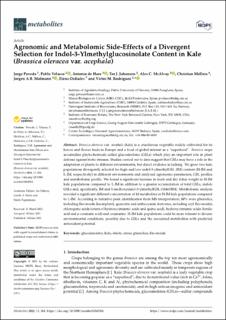Agronomic and Metabolomic Side-Effects of a Divergent Selection for Indol-3-Ylmethylglucosinolate Content in Kale (Brassica oleracea var. acephala)
| dc.contributor.author | Poveda, Jorge | |
| dc.contributor.author | Velasco, Pablo | |
| dc.contributor.author | de Haro, Antonio | |
| dc.contributor.author | Johansen, Tor Jacob | |
| dc.contributor.author | McAlvay, Alex C. | |
| dc.contributor.author | Möllers, Christian | |
| dc.contributor.author | Mølmann, Jørgen A | |
| dc.contributor.author | Ordiales, Elena | |
| dc.contributor.author | Rodríguez, Víctor M. | |
| dc.date.accessioned | 2022-01-17T12:09:08Z | |
| dc.date.available | 2022-01-17T12:09:08Z | |
| dc.date.created | 2021-09-28T10:07:29Z | |
| dc.date.issued | 2021-06-14 | |
| dc.identifier.citation | Metabolites. 2021, 11 (6), 1-15. | en_US |
| dc.identifier.issn | 2218-1989 | |
| dc.identifier.uri | https://hdl.handle.net/11250/2837640 | |
| dc.description.abstract | Brassica oleracea var. acephala (kale) is a cruciferous vegetable widely cultivated for its leaves and flower buds in Europe and a food of global interest as a “superfood”. Brassica crops accumulate phytochemicals called glucosinolates (GSLs) which play an important role in plant defense against biotic stresses. Studies carried out to date suggest that GSLs may have a role in the adaptation of plants to different environments, but direct evidence is lacking. We grew two kale populations divergently selected for high and low indol-3-ylmethylGSL (IM) content (H-IM and L-IM, respectively) in different environments and analyzed agronomic parameters, GSL profiles and metabolomic profile. We found a significant increase in fresh and dry foliar weight in H-IM kale populations compared to L-IM in addition to a greater accumulation of total GSLs, indole GSLs and, specifically, IM and 1-methoxyindol-3-ylmethylGSL (1MeOIM). Metabolomic analysis revealed a significant different concentration of 44 metabolites in H-IM kale populations compared to L-IM. According to tentative peak identification from MS interpretation, 80% were phenolics, including flavonoids (kaempferol, quercetin and anthocyanin derivates, including acyl flavonoids), chlorogenic acids (esters of hydroxycinnamic acids and quinic acid), hydroxycinnamic acids (ferulic acid and p-coumaric acid) and coumarins. H-IM kale populations could be more tolerant to diverse environmental conditions, possibly due to GSLs and the associated metabolites with predicted antioxidant potential. | en_US |
| dc.language.iso | eng | en_US |
| dc.publisher | MDPI, Basel, Switzerland | en_US |
| dc.rights | Navngivelse 4.0 Internasjonal | * |
| dc.rights.uri | http://creativecommons.org/licenses/by/4.0/deed.no | * |
| dc.title | Agronomic and Metabolomic Side-Effects of a Divergent Selection for Indol-3-Ylmethylglucosinolate Content in Kale (Brassica oleracea var. acephala) | en_US |
| dc.type | Peer reviewed | en_US |
| dc.type | Journal article | en_US |
| dc.description.version | publishedVersion | en_US |
| dc.rights.holder | © 2021 by the authors | en_US |
| dc.source.pagenumber | 1-15 | en_US |
| dc.source.volume | 11 | en_US |
| dc.source.journal | Metabolites | en_US |
| dc.source.issue | 6 | en_US |
| dc.identifier.doi | 10.3390/metabo11060384 | |
| dc.identifier.cristin | 1939539 | |
| dc.source.articlenumber | 384 | en_US |
| cristin.ispublished | true | |
| cristin.fulltext | original | |
| cristin.qualitycode | 1 |
Files in this item
This item appears in the following Collection(s)
-
Divisjon for bioteknologi og plantehelse [522]
Publikasjoner knyttet til ansatte ved Divisjon for bioteknologi og plantehelse -
Divisjon for matproduksjon og samfunn [983]
Publikasjoner knyttet til ansatte ved Divisjon for matproduksjon og samfunn -
Publikasjoner fra CRIStin - NIBIO [4501]
-
Vitenskapelige artikler [1416]

